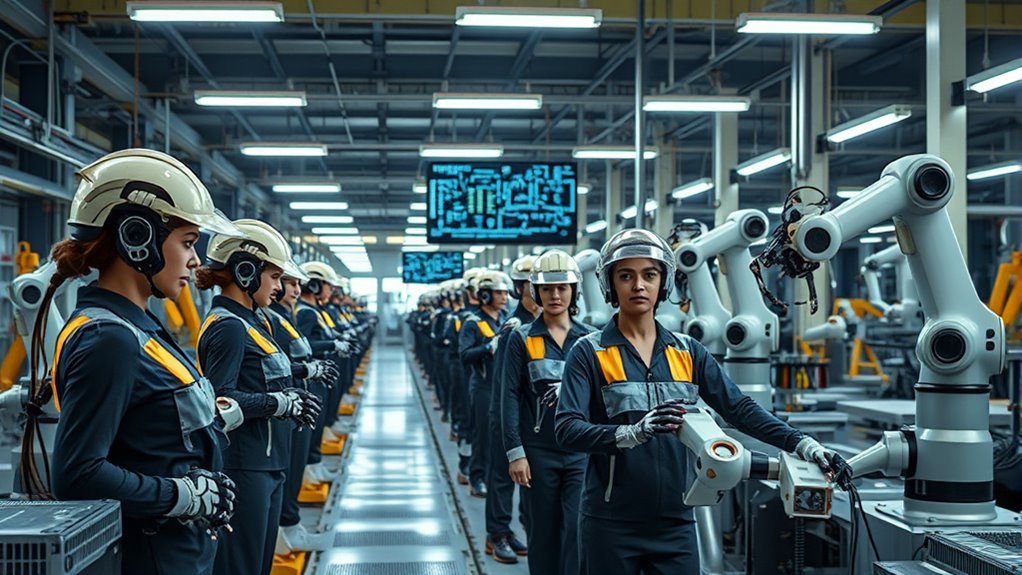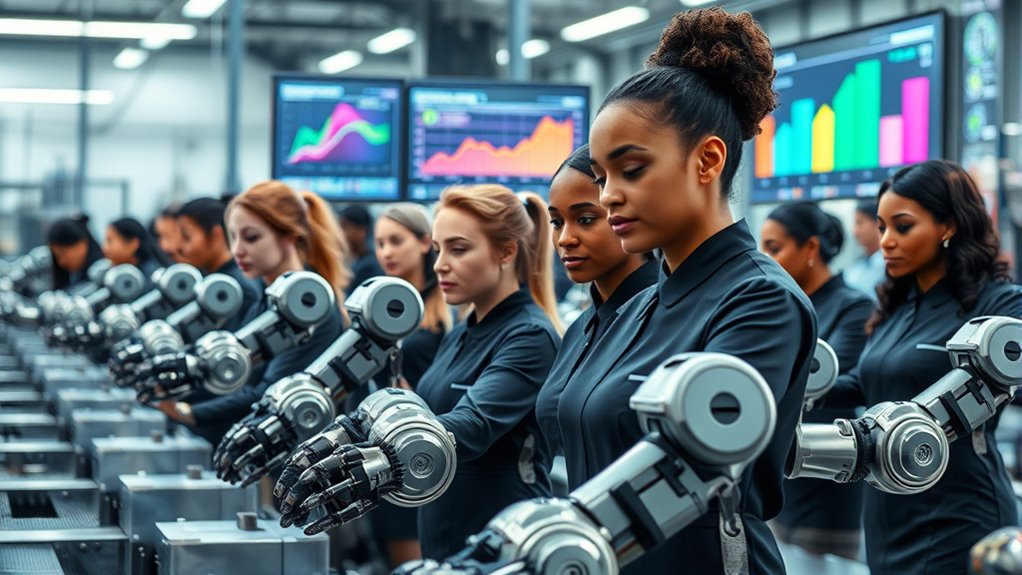AI automation threatens to widen gender gaps in the workforce, as women are more likely to hold jobs vulnerable to automation, especially in administrative and service roles. The tech industry also underrepresents women, limiting their opportunities in AI careers and leadership. Long-term, these trends could reduce women’s labor share unless targeted policies and skills development are put in place. To understand how these shifts might unfold, explore what strategies can bridge this growing divide.
Key Takeaways
- Women face higher automation risks due to occupational segregation into routine, vulnerable jobs like administration and clerical roles.
- Women are underrepresented in AI and tech sectors, limiting their opportunities and leadership growth in future AI-driven industries.
- AI-driven displacement may disproportionately affect women in manufacturing and customer service, widening the gender employment gap.
- Countries with more balanced AI workforce participation show smaller gender gaps, highlighting the importance of regional policies.
- Targeted upskilling, inclusive policies, and diversity initiatives are essential to prevent deepening gender disparities amid automation.
The Disproportionate Impact of AI Automation on Women’s Employment

Women face a disproportionately higher risk of job displacement due to AI automation because many of their jobs are highly exposed to technological change. About 80% of women in the workforce work in occupations vulnerable to AI, especially in administrative and clerical roles, which are prime targets for automation. In high-income countries, the automation risk for female-dominated jobs is nearly three times higher than for male-dominated ones—10% versus 3.5%. In Europe and Central Asia, 39% of women’s jobs could be affected compared to 26% of men’s. Occupational segregation plays a role, as women tend to work in white-collar roles with routine tasks that AI can easily automate. This concentration of women in vulnerable sectors increases their exposure to displacement and job insecurity in the evolving AI landscape. Recent research indicates that women’s employment is more sensitive to technological disruptions due to their occupational distribution. Recognizing Occupational segregation can help develop targeted policies to mitigate these disparities and promote inclusive economic resilience.
The Gender Divide in AI Talent and Workforce Participation

Despite making up nearly half of the overall workforce, women hold only about 29% of positions in AI and the broader tech industry. Your experience highlights how female representation drops sharply at higher levels, with just 26% in data and AI roles and 35% in the tech workforce overall. Challenges include:
- Lower promotion rates: for every 100 men promoted, only 52 women advance.
- Difficulties retaining women despite participation gains.
- A shortage of qualified female AI candidates.
- Underrepresentation in executive and leadership positions.
Educationally, women earn only 18% of computer science degrees, with even fewer Black and Hispanic women. This talent gap, combined with biased hiring practices and workplace cultures, limits women’s participation and advancement in AI careers. Additionally, contrast ratio plays a pivotal role in how visual information is perceived, which can influence user interfaces and experiences designed by diverse teams.
Long-Term Trends and the Future of Gender Equality in the AI Era

As AI continues to reshape the job market, understanding its long-term impact on gender equality becomes essential. Job displacement may hit women harder, especially in sectors vulnerable to automation like manufacturing and customer service. Meanwhile, the growing demand for AI skills could widen the gender gap unless women receive targeted training to bridge this divide. Although new roles will emerge, they often require advanced STEM knowledge, which women are less likely to hold. Some industries, like healthcare and education, may experience less automation, helping preserve women’s labor share. To guarantee progress, governments and organizations must implement policies supporting women’s transition into AI-compatible roles, promote female representation in AI development, and foster a culture of diversity and inclusion to shape a more equitable future. Incorporating Aromatherapy Naturals techniques and principles can also help support women’s well-being during these transitions.
Regional Variations and Economic Risks of the AI Gender Gap

Regional differences in AI workforce gender representation reveal significant disparities that can influence local economic stability and growth. You’ll notice that some countries, like Latvia, Finland, Italy, Iceland, and India, have a smaller gender gap in AI sectors, hinting at more balanced opportunities. Conversely, nations such as Portugal and Estonia show near gender parity overall but face stark imbalances within AI roles, with differences up to 51%. Most EU countries experience AI gender gaps of 40-50%, despite having less than 10% overall workforce gender disparities. These variations highlight how local labor market gender equity doesn’t always translate into AI sector balance. Additionally, wall organization systems in workplaces can play a role in supporting gender-inclusive environments, promoting equitable participation in tech fields.
- Women’s AI usage drops sharply with age, below 35% over 55.
- Men’s AI use remains high across all ages, over 60% under 45.
- AI job disruption threatens women in roles like administration.
- Gender gaps persist despite high university graduation rates for women.
Strategies to Bridge the Gender Divide in the Age of Automation

Bridging the gender divide in the age of automation requires targeted strategies that address the unique vulnerabilities women face due to AI-driven job displacement. You should focus on gender-sensitive upskilling and reskilling, especially in sectors like administration, healthcare, and customer service where women are overrepresented. Programs must close digital skills gaps and offer accessible AI training for women with both STEM and non-STEM backgrounds. Partnerships between governments, businesses, and worker organizations are crucial to support women’s transition into future-proof roles. Implementing bias testing and transparency in AI systems helps prevent discrimination. Promoting diverse development teams and inclusive workplace policies encourages participation. Additionally, creating leadership pathways and lifelong learning opportunities enables women to advance and thrive amid automation’s evolving landscape. Prioritizing inclusive policies can significantly accelerate progress toward gender equality in the AI economy. Recognizing the importance of roles like AI Ethicist Jobs, which involve shaping moral frameworks for technology, is essential for ensuring ethical considerations are central to AI development.
Frequently Asked Questions
How Can Policies Effectively Encourage More Women to Pursue AI Careers?
You can encourage women to pursue AI careers by implementing targeted scholarships, mentorship programs, and inclusive hiring policies. Expand STEM education with gender-sensitive approaches, offer accessible upskilling, and promote participation in workshops and online courses. Support flexible work environments, leadership development, and anti-discrimination measures. These policies help build confidence, reduce barriers, and create a welcoming ecosystem that motivates women to enter and thrive in AI fields.
What Role Do Educational Institutions Play in Reducing the AI Gender Gap?
Oh, educational institutions are just sitting back, letting gender stereotypes shape future tech leaders, right? Actually, they play a vital role in closing the AI gender gap. By updating curricula, challenging stereotypes, providing access to AI tools, and promoting STEM among girls, they can foster confidence and skills. Mentorships, role models, and inclusive policies turn classrooms into launchpads, helping women step confidently into AI careers instead of watching from the sidelines.
How Does AI Automation Impact Women’S Entrepreneurship and Small Business Opportunities?
You see, AI automation can create both opportunities and challenges for women’s entrepreneurship and small businesses. It boosts productivity, enables personalized customer experiences, and helps access new markets, especially in health and wellness. However, it also risks job displacement in routine roles, often held by women. To thrive, you should leverage female-focused networks, mentorship, and collaboration platforms, turning automation into a tool for growth rather than a barrier.
What Are Successful International Models for Increasing Female Representation in AI?
You’re on the right track by exploring international models, as success stories often speak louder than words. Eastern European countries like Latvia and Lithuania excel by promoting women in STEM through historical and policy support, leading to higher female AI representation. Meanwhile, visibility campaigns and role models in Europe boost women’s participation. These examples show that targeted policies, cultural encouragement, and highlighting female achievements are key to closing the gender gap in AI.
How Might Ai-Driven Labor Shifts Influence Gender-Based Income Inequality Long-Term?
AI-driven labor shifts could substantially reduce gender-based income inequality over time. You might see more transparent pay practices, automated bias detection, and real-time adjustments, helping close wage gaps. AI can also boost women’s access to high-paying STEM roles by offering targeted training and mentorship. As organizations adopt these tools, you’ll notice faster, fairer salary decisions, ultimately promoting greater gender pay equity and increased women’s participation in lucrative sectors.
Conclusion
As you navigate the AI revolution, remember that the gender gap is a crack in the foundation of equality. By actively supporting inclusive policies and fostering diverse talent, you can help bridge this divide. Think of AI as a rising tide—if everyone isn’t on deck, some will be left behind. Together, you can steer this ship toward a future where women’s labor share isn’t just a ripple, but a steady current of progress.









